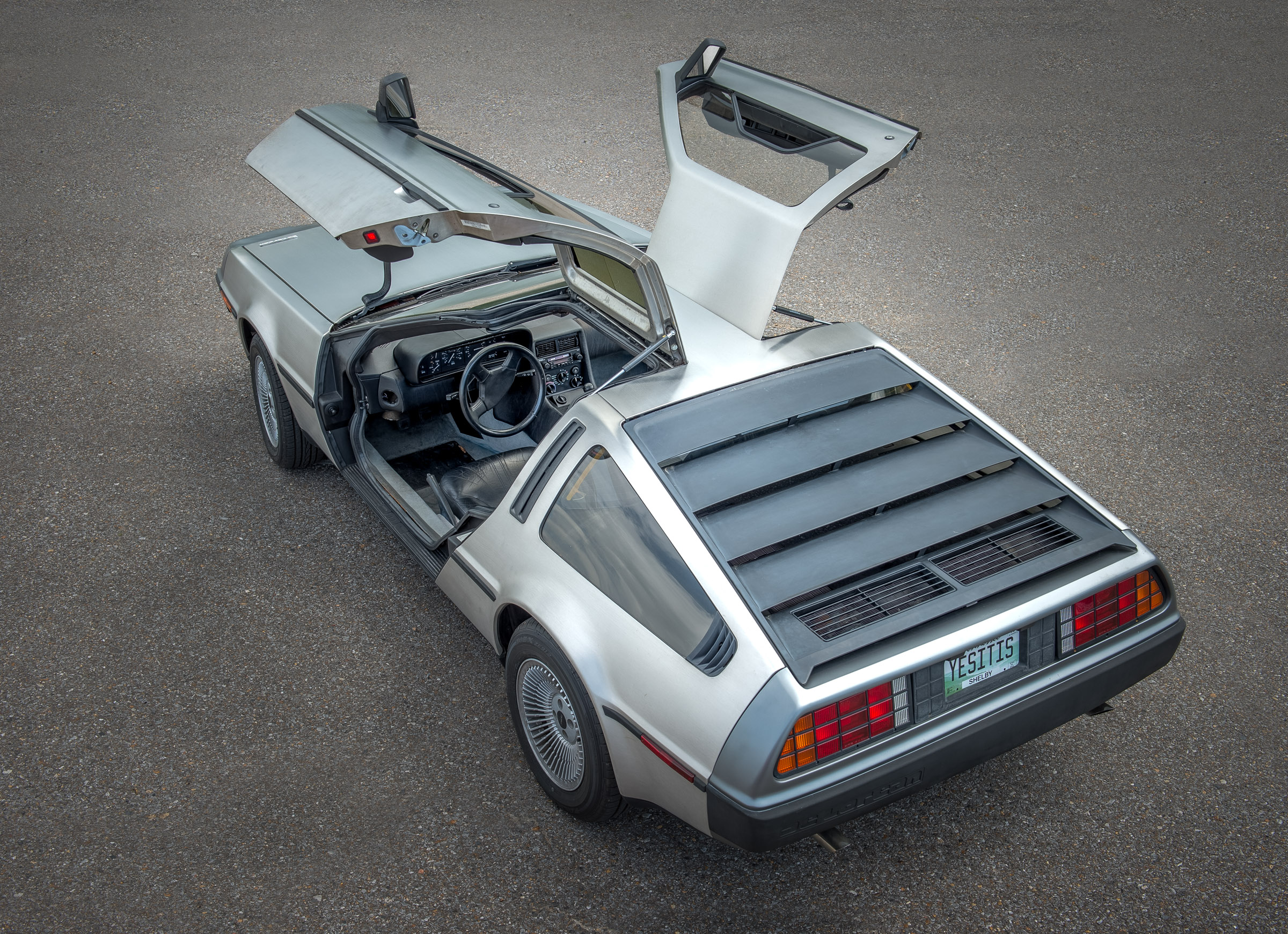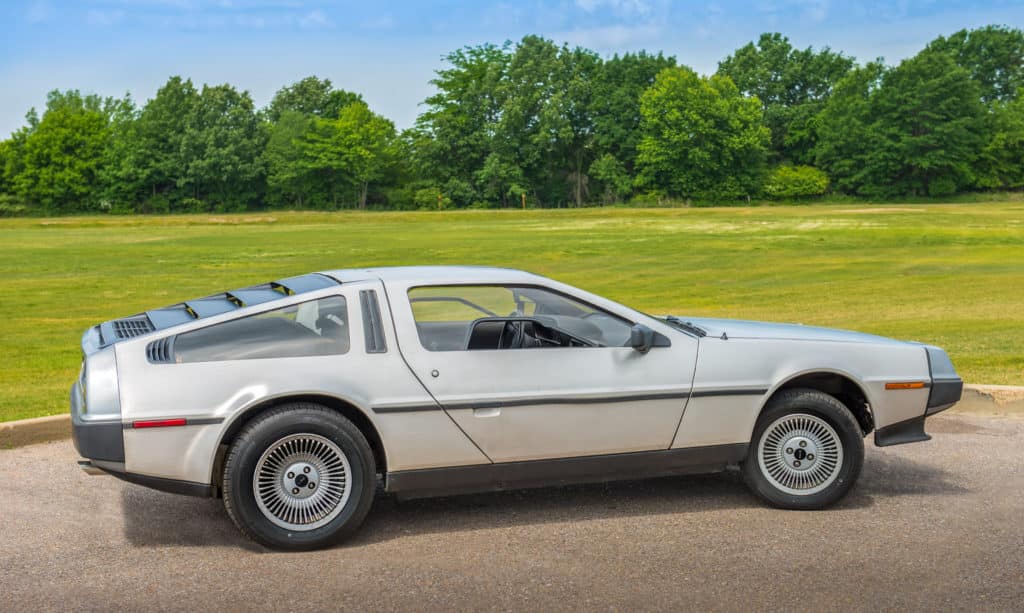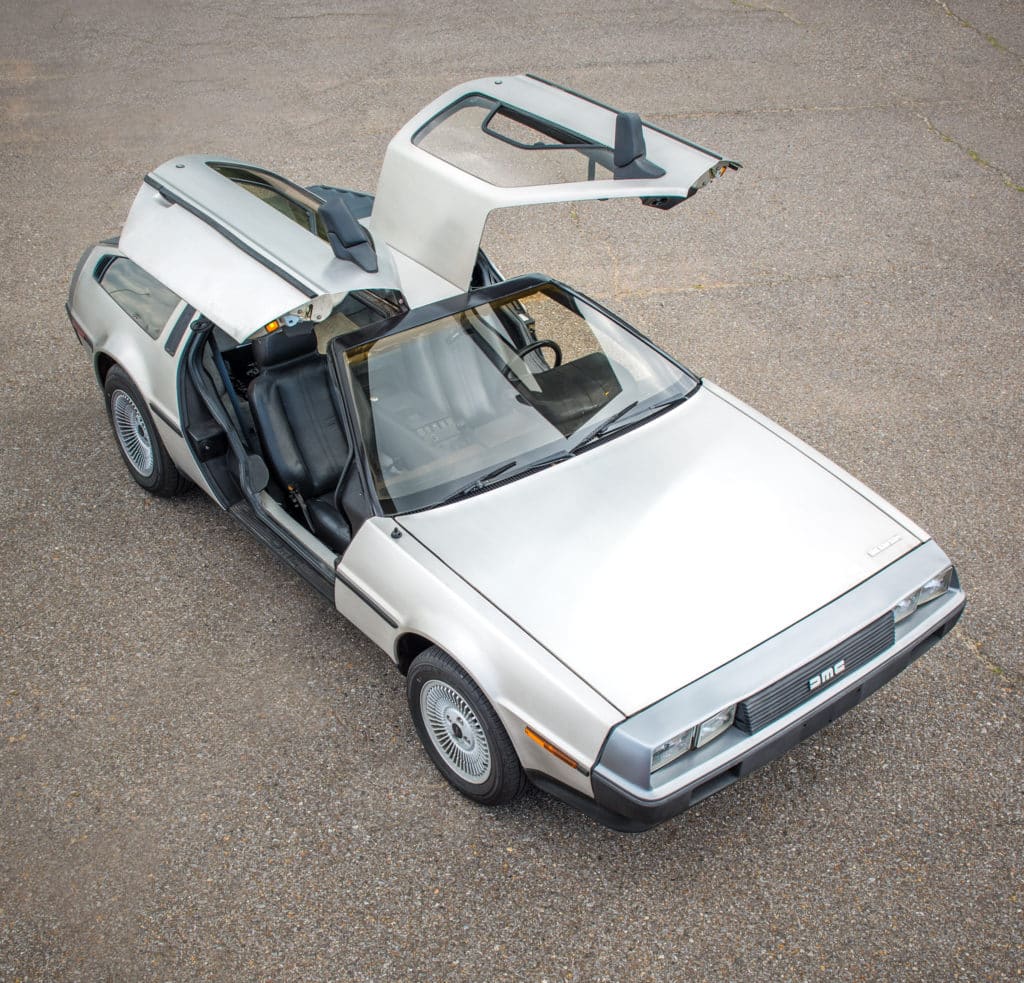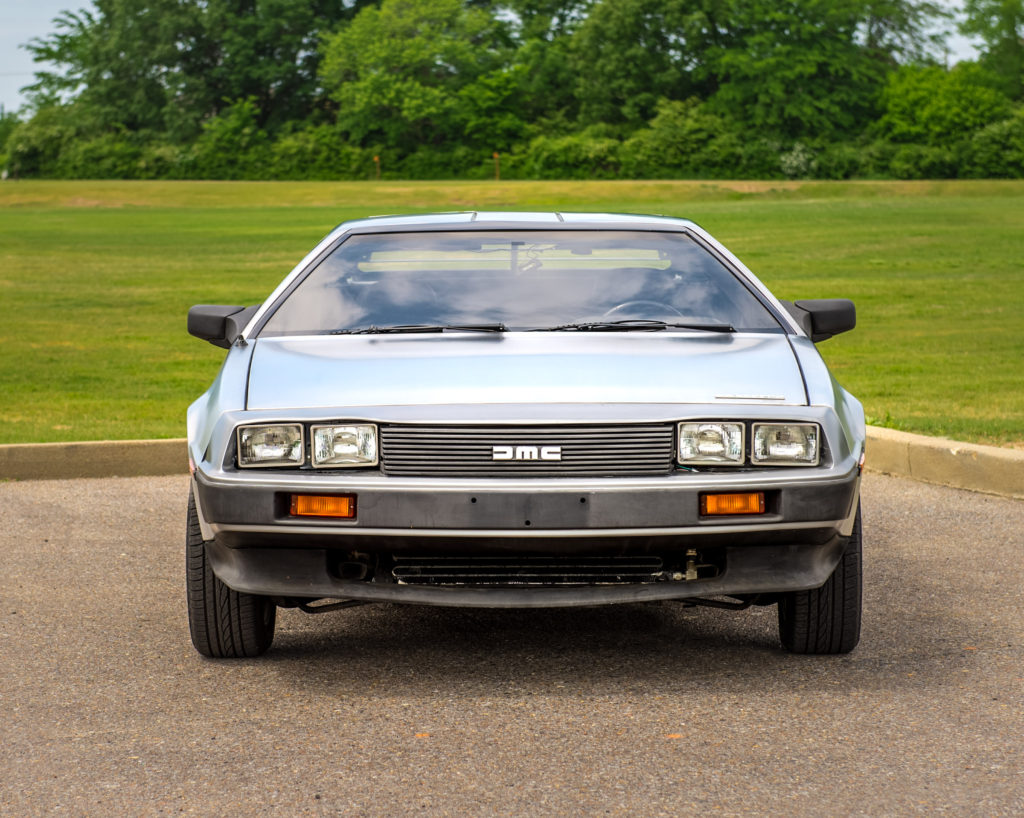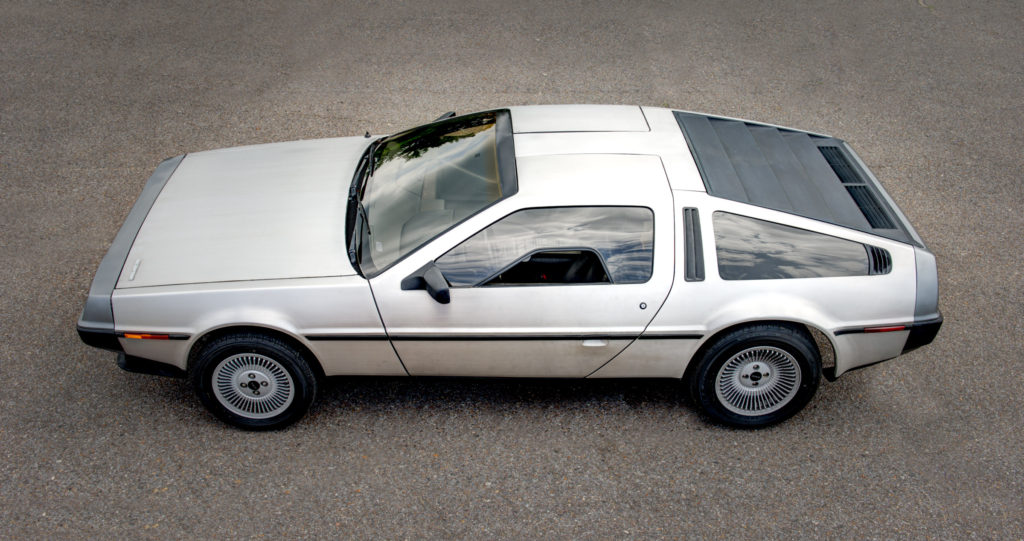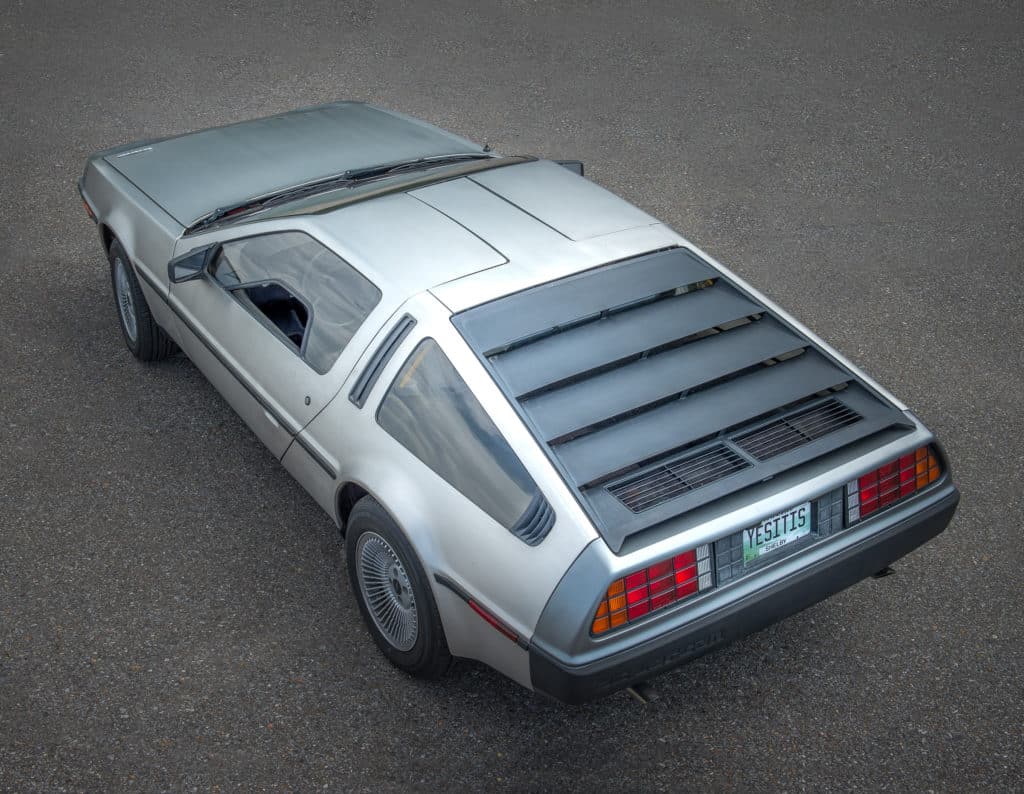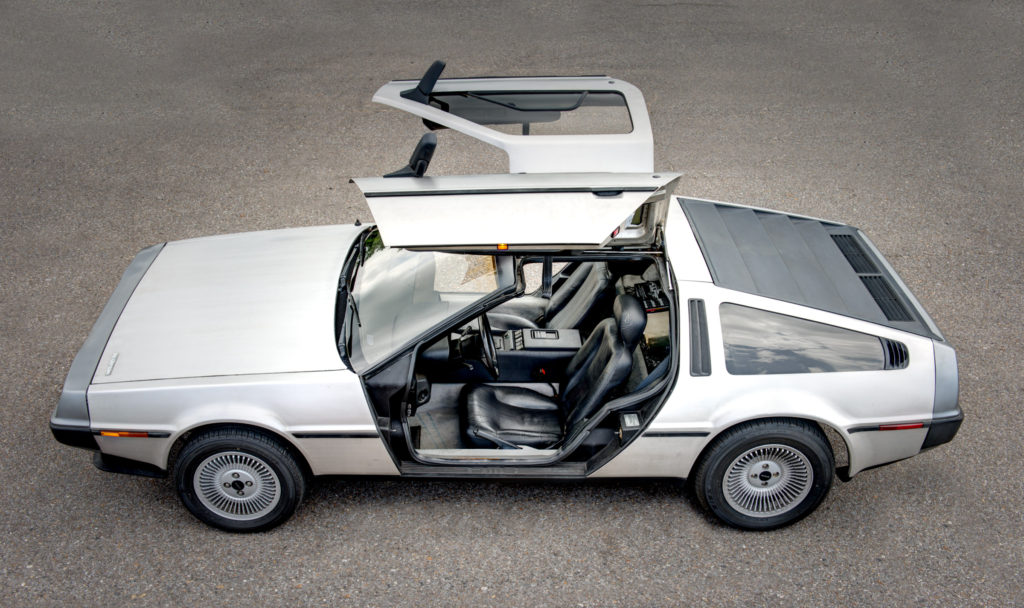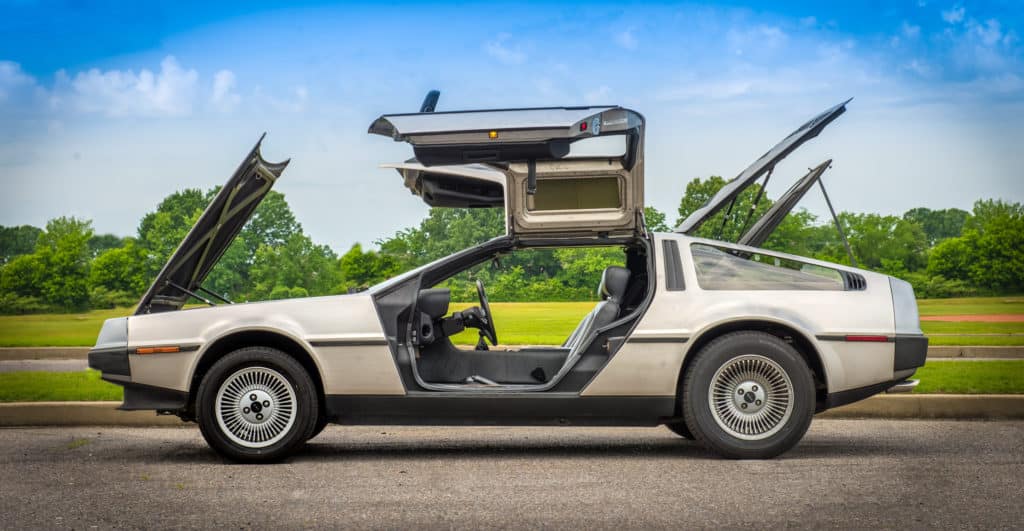By William Horton
This is the seventh in a series of articles on “Cars we have photographed and loved.”
The history of the DeLorean DMC-12 is not just a story of gullwing doors and stainless steel skin. Nor one of overhead cams and gear ratios. It is a saga of soaring hopes, tragic failure, and scrappy redemption.
Download a PDF-version of this article.
The DMC-12 was the only product of the DeLorean Motor Company. Founded 24 October 1975 by John DeLorean, the DeLorean Motor Company (or just DMC) was the first new US car company since 1925. Headquartered in Detroit with its sole factory in Northern Ireland, DMC seemed set to soar. In 1982, after only two years of production, DMC sank into bankruptcy and receivership. But DeLorean was more than a boring business obituary.
John Zachary DeLorean
The story of DeLorean, the car, and DeLorean, the company, are inseparable from the story of DeLorean, the man. John Zachary DeLorean was a brilliant automotive engineer with a reputation as a tireless worker and visionary designer. As Pontiac’s chief engineer, he led development of GM’s premier muscle car, the Pontiac GTO. Based on that success, he became the youngest vice-president in General Motors’ history, heading the Chevrolet and Pontiac divisions.
John DeLorean was not your bland, generic corporate executive. He stood out. Movie-star good looks graced his athletic 6-foot 4-inch frame. He wore bright suits and appeared in public in casual clothes. He let his hair grow out. No surprise, he dated and married beautiful women, including fashion model Cristina Ferrare. He eschewed limos and spurned even GM’s Corvette, preferring to drive exotic European sports cars instead. Outspoken, DeLorean was always good for a quote.
When DeLorean left GM in early 1970, announcing his intention to build a “safety-minded” sports car, great things seemed in the offing. As if scripted by Sophocles, John DeLorean’s fall could not have been more dramatic and tragic.
In 1981, the FBI launched a sting aimed at drug traffickers. On the Feds radar was a flamboyant auto tycoon who’d located his factory in Northern Ireland rather than Puerto Rico, as some in the US government had expected. After a videotaped meeting with undercover FBI agents, DeLorean was arrested in October 1982, charged with conspiring to smuggle $24 million of cocaine to the US. The core of the government’s case was the murky video that showed a hotel room, suitcases of cash, and John DeLorean calmly talking about the economics of cocaine distribution. Not good for the hero of our story.
However, DeLorean was acquitted, the jury, apparently feeling he was entrapped by undercover FBI agents who had approached him posing as legitimate investors. No matter; the harm was done. DeLorean (and by implication his company) was tainted. Quipped DeLorean, “Would you buy a used car from me?”
OK, that’s how it began and how it ended. How did we get from triumph to disaster? And was it really a disaster at all?
DMC a financial drama
[sta_anchor id=”financial-drama” unsan=”financial drama” /]Now we turn to the story of DeLorean, the company. And that is primarily a story of high finance, involving Hollywood celebrities and groups of people struggling to kill each other. Though the specific financial machinations (shenanigans?) behind DMC were more complex than a Formula 1 drive train, one thing is simple: The whole history of DMC was a struggle to obtain funds.
With seed money from private investors, such as Tonight Show host Johnny Carson, Rat Pack charter member Sammy Davis, Jr., and country-music star Roy Clark, DeLorean was off and crawling. Bank of America chipped in some business loans, but the largest contribution was from the UK government.
That was a deal of desperation. The UK’s Labour government, tired of just sending more troops to quell violence in Northern Ireland, was desperate to create jobs in this blighted region, where the lack of such jobs left lots of Catholic and Protestant men with little else to do but bomb, kidnap, and just plain murder each other—as well as the British troops tasked with preventing said mayhem.
DMC needed a total of $200 million, and the Industrial Development Organisation for Northern Ireland was offering £65 million. A quick clickety-clack of the calculator showed that was $120 million in US dollars! Of course, the UK’s own business consultants gave the venture only a 10% chance of success.
And all DMC had to do was build an entirely new factory in record time in an area beset with sectarian violence. Oh, and staff it with the same people committing that violence. What could go wrong?
With the bulk of the financing in place, Wall Street bankers and brokers ponied up the rest, largely on the reputation of John DeLorean.
Soon, of course, more money was needed. Efforts to obtain it were clever to say the least. Contracts with suppliers were renegotiated. Suppliers were promised they’d be paid by the UK government. Dealers received stock in the company instead of payments for warranty work.
When nothing seemed enough, a plan to restructure the company was hatched (Isn’t it always?). However, the spoil-sport US Securities and Exchange Commission, lacking faith in the viability of the reorganized company, vetoed that plan. Even John DeLorean’s drug-smuggling charges stemmed from attempts to lure new investors.
The complex financing had a simple end; DMC ran out of money and filed for bankruptcy in late 1982.
Development, innovation, evolution, and variations
While John DeLorean and top brass struggled to obtain financing, the engineers set about the task of making a worthy car.
Z Tavio?
The DMC-12 is better known simply as “the DeLorean.” However, the original name of the car may have been “Z Tavio” as appeared on some early engineering drawings. This name probably referred to Zachary Tavio DeLorean, John’s son. Tavio was also John’s father’s name, and Zachary was John’s middle name. What is not clear is whether this was just a code name or was really the intended product name.
First prototype
DMC’s chief engineer William T. Collins, who had replaced John DeLorean as chief engineer at Pontiac, completed the first prototype for the DMC-12 in October 1976. Styling was by Giorgetto Giugiaro of Italdesign Giugiaro. The design was innovative but not radical, incorporating gullwing doors, a low-wide stance, and stainless-steel skin.
Gullwing doors were uncommon but not unique, having appeared on the Mercedes 300SL. Ensuring the heavy doors rose completely and reliably, required gas-charged struts and cryogenically preset torsion bars, developed by Grumman Aerospace.
One unique feature was the stainless steel skin. The non-structural panels of brushed SS304 stainless required no paint or clear coat to resist corrosion and fading.
Just as the skin was innovative and interesting, the drive train was dishwater dull. For a power plant, DMC settled on the Peugeot-Renault-Volvo (PRV) unit manufactured at the PRV factory at Douvrin in northern France. This fuel-injected, 130-horsepower unit was mated to a PRV gearbox made by Renault in Caen, France.
Lotus hired to re-engineer
Unfortunately, this early design relied on a novel manufacturing technology that proved inadequate. As a result, the DMC-12 needed complete reengineering before it could be put into production.
The task of reengineering the unmanufacturable prototype was given to Lotus’s racing and production car facility in England. Headed by company founder and owner Colin Chapman, Lotus redesigned the car around a backbone (double Y) chassis like that in the Lotus Esprit. Stainless panels were then attached to a fiberglass monocoque underbody. Though good at hand-building high-performance racing cars, Lotus was yet to perfect mass manufacturing of passenger cars, so considerable delays accumulated before high-quality production could begin.
Compromises hobble performance
The DMC-12 never realized the potential hinted at in the early prototype. DMC had planned to use an entirely new manufacturing process called Elastic Reservoir Molding (ERM), to streamline production and reduce weight. Only after purchasing the patents for the process did DMC realize how impractical the process was and was forced to shift to a more conventional fiberglass molding process licensed from Lotus.
The original engine choice was Comotor’s Wankle rotary engine; however, this powerful, but thirsty, unit became unavailable, and DMC ultimately had to settle for the less-powerful PRV engine. To make matters worse, the required addition of emissions abatement systems to the PRV engine lowered HP from 170 to 130.
The change of engine also shifted weight rearward. Originally the DMC-12 was to be a true mid-engine, with the power unit between the passenger compartment and rear axle. Fitting the PRV required placing the engine rear of the wheels, thus putting 65% of weight on the rear wheels, not a disaster, but not ideal for handling.
Bumper and collision regulations required raising the front. At just the wrong time, the US National Highway Traffic Safety Administration issued height requirements for bumpers and headlights. DMC, finding it too late to reposition the lights and bumpers, had no choice but to raise ride height, especially in the front. This degraded handling and gave the car an awkward upward tilt, as if hauling something heavy in the back, something like a lump of French iron.
Continuous evolution, not model-year madness
DMC continued to improve the DMC-12 throughout its life. Unlike typical American car companies, DMC made changes as needed and as possible rather than bunched up into model-year revisions.
As a result, there is little difference among ’81, ’82, and ’83 versions. (Actually, there is no difference with ’83s as these were rebadged ’82s.) Here’s a list of ways DMC improved the DMC-12. They:
- Tinkered with the hood (bonnet to speakers of the Queen’s). The gas flap was moved, a non-locking gas cap was fitted, a name badge was added, and finally the side grooves vanished.
- Added a pull strap to enable those of less than John DeLorean’s six foot four height to close the doors.
- Integrated the side bolster into a single trim piece. This piece had tended to break off as result of its natural use as a hand rest when entering and exiting.
- Added a foot rest (“dead pedal”).
- Switched from painted gray to polished silver wheels. At the same time, center caps went from gray with an embossed DMC logo to black with the logo painted silver.
- Switched from a Craig cassette/radio with a separate clock to an ASI stereo with an integrated clock.
- Moved the radio antenna about. The nomadic radio antenna started out embedded in the windshield. Poor reception resulting in continual seeking for a signal, led engineers to switch to a whip antenna mounted on the outside of the front right fender. Complaints about appearance led to an automatically deploying antenna mounted under the left side grills behind the driver. This completely hid the antenna when not in use.
- Flipped the sun visors. Originally visors had the vinyl side in and headliner side out when deployed. This was reversed.
- Alternated the alternator. The anemic Ducellier alternator was replaced with a more powerful Motorola alternator. One reason for this change was to compensate for failures of the door switch to turn off the lights around the perimeter of the door. This failure left the lights on even when the door was closed and ran down the battery. That’s what happened to Johnny Carson’s DMC-12. This change also fixed the timid-sounding horn.
So, DeLoreans are not all the same as they first appear.
Variants
In its short life, the DMC-12 had only a couple of factory-authorized variations.
A handful of right-hand drive units were produced. Intended primarily for the US Market, the DMC-12 was designed with the steering wheel on the left. The factory did commission a small number of right-hand drive conversions. Twenty such conversions were ordered from Woolser-Hodec in England; but, only 13 were completed before DMC failed. Another batch of three were produced for use by the factory.
If you didn’t like stainless, you could go gold. For a promotion of its Gold Card, American Express included a gold-plated DeLorean in its 1980 Christmas Catalog for a mere $85,000. Oh, come on, that’s only a $60,000 increase over the base price of $25,000. AMEX and DMC planned for 100 units; they sold two. Shocking! One sat in the lobby of Snyder National Bank in Snyder, Texas, for 20 years. A third was built from parts set aside in case repairs were needed on the first two.
The exact number of DMC-12s built is unclear. If you need a number, use 8,583 as that is often cited. Or try 9,080 as that also has some currency. Part of the imprecision comes from questions about how many post-bankruptcy units to include
Manufacturing facility
Manufacturing the DMC-12 was as much a challenge as designing it. Assembly was performed by DeLorean Motor Cars, Ltd. (DMCL), whose first task was to build a factory. And that they did—in a 72-acre cow pasture in Dunmurry, a suburb of Belfast, Northern Ireland. Dunmurry was an area of high and long-term unemployment. The times were known as “The Troubles” because Protestants and Catholics were killing one another, and neighborhoods were completely segregated with walls and barricades.
The factory rose right on the border between Protestant Dunmurry and Catholic Twinbrook, requiring separate entrances. Construction began in October 1978 and was completed 16 months later. Production was supposed to begin in 1979, but design and engineering delays ensured that the first car did not come off the line until 3 December 1980, and production did not start in earnest till 21 January 1981. The first production model premiered at the Geneva Motor Show in February 1981.
Not an overwhelming success
Initial reception by the car-buying public and the automotive press was lackluster. The DMC-12 was perceived as too expensive, slow, odd, late, unreliable, and unvarying. Some of these perceptions were exaggerations or outright mistakes, but not all.
The price was not right. At that time a well-equipped and thoroughly sorted Corvette was just $16,000; therefore, the DMC-12’s suggested retail price of $25,000 seemed a mite high. After all, the 12 in DMC-12 supposedly stood for the target price of $12,000. What critics failed to take into account were the many standard features that were options on other cars: air conditioning; leather seats; tinted glass; AM/FM cassette stereo; power locks, windows, and mirrors; telescoping and tilting steering wheel; electric rear-window defogger; intermittent windshield wipers; and four-wheel power disc brakes.
Performance was … ahem … mediocre. Road & Track clocked a zero-to-sixty time of 10.5 seconds. A Porsche of the time could do that in 6.3 seconds. Today a Honda Civic can make sixty in 8.6 seconds. There’s no way around it, the engine was underpowered. Instead of a screaming V8 or a shrieking V12 or even the planned humming Wankel, the DMC-12 got a wheezing V6 with a whopping 130 horsepower. Well, at least it got good fuel mileage: low 20s in town and high 20s on the road.
To some, the DMC-12 seemed a bit odd. It was an unusual car, but debate raged about what was a strength and what was a weakness.
The stainless skin attracted admiring glances and caresses of strangers. The latter left fingerprints that turned into dark blotches that proved hard to remove.
Different sized front and rear tires caused some to worry about what size spare tire to carry. Others worried how, with just a small inset and no full-sized window to roll down, they could get out in case of an electrical failure or even how they could pay tolls.
The stainless steel skin was supposedly a nightmare to repair. You couldn’t just have your local body shop slather on some Bondo and respray. DMC dealers recommended replacing dented panels, an option that gave pause to those in areas prone to hail storms. The truth is that repairing dents is possible, but it requires a specialist. The British TV series Wheeler Dealers (Season 8, Episode 7) shows how.
One of the funniest rumors was that the DMC-12 required three parking spaces: one for the car itself and one on each side for the gullwing doors to open. This was totally false, as the doors required only 11 inches to open, less than for a conventional door.
To many, the DeLorean looked awkwardly wide and low. In ironic revenge, that stance is now popular among Lambos and Ferraris.
The DMC-12 was late to market. By the time the DMC-12 reached its intended market, the US economy was in recession. Car sales dropped more than any time since the 1930s. The exchange rate on the US dollar made the car more expensive still. Poor DMC got to the party after the cashews were all gone.
Initial models were reliably unreliable. DMC faced a myriad of small problems typical for a new manufacturer’s first product. The design was new. It was assembled in a new factory built from scratch using novel processes and unusual materials. Few workers had experience in automotive manufacturing, and many lacked any manufacturing experience at all. There was little time for training.
First impressions were bad. After only a few miles, the DMC-12 allotted to Tonight Show host Johnny Carson (also an investor in DMC) came to a halt. A replacement part fixed the problem, but only for a few days.
In 1981, to deal with widespread quality problems, DMC set up Quality Assurance Centers (QAC) in New Jersey, Michigan, and California to rework cars before delivery to skeptical dealers. Rework included adjusting gullwing doors to fix leaks, refitting misaligned body panels, and replacing faulty switches and inadequate alternators. To complicate matters, some dealers refused to do warranty work, as they were not reimbursed for such work. However, by the end of 1981, DMC had quality in hand and could discontinue the QACs.
DMC-12s all looked the same. DMC-12s were virtually identical. The only factory option was an automatic transmission and choice of black or gray interior. If you were the first in your social circle to own one, you were special. If you were second, you were just a copycat—and the enemy of the one who bought the first one. Henry Ford is reported to have said customers could have their Model T in any color so long as it was black. John DeLorean might have said, “any color so long as it is brushed stainless steel.”
Other than the three gold-plated units and a handful of right-hand drive conversions, only minor visual differences distinguish one iteration of the DMC-12 from another: the gas flap disappeared from the hood, the radio antenna bounced to different locations, and wheel hubs changed color. Though the factory experimented with tinted paint and some dealers tried painting over the stainless, the stainless stubbornly resisted tints and paint (but not fingerprints).
The hype about the DMC-12 led to disappointment. It was not a bad car, just not as great as promised. It lacked the performance of a super car … or even a good sports car. And it cost way more than proven sports cars. Competitors, such as Jaguar, Corvette, and Porsche, had spent decades perfecting their product and building their reputations. To survive, the DMC-12 needed instant, overwhelming success. It fell a tad short.
DMC is dead. Long live DMC.
The DeLorean Motor Company died with its bankruptcy in 1982. Or did it? Yes, it did. But, as with everything else in this story, the truth is more complex.
After the bankruptcy, a company called Consolidated International (now Big Lots) bought the entire DMC-12 parts chain, including all unsold cars, incomplete cars, parts at the factory, parts on the way from suppliers, and parts in the US Warranty Parts Center. They shipped the whole big lot to Columbus, Ohio. Operating as KAPAC, they sold parts wholesale and retail by mail order. They hired former DMC managers to complete about 100 unfinished cars. They even gave 1983 VINs to about 1000 of the units made between February and May of 1982.
Yes, there is currently a DeLorean Motor Company. It is not the original DMC emerged from Bankruptcy. It is an entirely separate company, never associated with the original company. It was founded by Liverpool-born mechanic-turned-entrepreneur, Stephen Wynne. The new DMC acquired the remaining parts from Consolidated International and also rights to the DMC logo.
Headquartered in Humble, Texas, near Houston, the new DMC has dealers in Bonita Springs, Florida; Crystal Lake, Illinois; Huntington Beach, California; Bellevue, Washington; and, Hem, The Netherlands. DMC supplies DMC-12 parts, including original factory items, made-to-order reproduction parts, and improved parts to fix problems in the originals.
DMC, and third party restorers, can make “new” cars from the available stocks of parts. Built on factory underbodies, these newly manufactured units get the VIN of the underbody and hence are titled as the year of that underbody, 1981 or 1982.
Back to the Future
On 2 July 1985, the DMC-12 seemed an oddity; beloved by its fanatical owners although virtually unknown by the general public, or else seen as a business-school case study on financial disaster. The next day it all changed.
On 3 July 1985, the comic sci-fi movie Back to the Future premiered. Overnight the movie transformed the DMC-12 into a pop-culture icon with a cult following and put flux-capacitor in the automotive jargon.
In the movie, teenager Marty McFly (played by Michael J. Fox) travels back in time using the home-built time machine created by eccentric Dr. Emmett “Doc” Brown (played by Christopher Lloyd). Doc had the genius to build his time machine on a DeLorean chassis.
The movie hit gold. It grossed $300 million, the best of any movie in 1985. It won Hugo and Saturn awards for science fiction, Academy Award and Golden Globe nominations, and a place on the American Film Institute’s Top 10 List of Science Fiction Films. Ronald Reagan even quoted from it in his State of the Union address in 1986: “Where we’re going, we don’t need roads.”
The DMC-12 also appeared in the two sequels of the movie franchise. All in all, six DMC-12 chassis were used, along with a seventh fiberglass model reserved for flight scenes. Three of the movie cars still exist. One was destroyed at the end of Part III.
Back to the Future got people to take a second look at the unique DMC-12 and appreciate it for what it was, rather than comparing it to other cars.
A Specimen of the Species
The example pictured in this article is a 1982 DMC-12 owned by Mollie and Mike Swindle. It is a good example of a survivor undergoing gentle and loving restoration. OK, there are a few nicks in the upholstery and not everything works perfectly. Still, it shows why collectors are passionate about these movie stars.
The simple, smooth, unique, styling of the DeLorean DMC-12 checks all the boxes for iconic design. No scoops, wings, or cowls interrupt the monochrome combination of straight lines and rounded corners.
The DMC-12’s nose-high stance made it appear to be lifting off the ground. Such height raised questions about the effectiveness of the modest front spoiler. Some owners have lowered the chassis to improve handling and appearance. Others just appreciate the ability to float over speed bumps that would disembowel an equivalent Lotus.
Viewed from any angle, the DMC-12 exhibits clean lines and an understated simplicity that shows off its signature stainless-steel panels.
Note the small inset window. That’s the only part of the door window that opens: making for awkward interactions with police and toll-booth operators.
The louvers, reminiscent of those on a Boss 302 Mustang, do not cover glass. Instead they cover the open space above the horizontal engine cover. Their function is visual and aerodynamic, providing a smooth transition from roof to tail.
Despite its low sports-car seating, the DMC-12 is easy to enter and exit. Credit the enormous gullwing doors that create an opening to accommodate even tall customers.
Mechanical engineers are now worrying about torsional rigidity with such holes sliced through the basic cylindrical shape. Surprisingly, incidents of jammed doors are rare.
The passenger compartment is not the only one with wide doors. Storing an overnight bag or servicing the engine presents no great problem.
While we’re here, notice the different front and rear wheel sizes. From this viewpoint you can see how the front is slightly raised, especially when you compare the open space above front and rear wheels.
Though not the most stunning view, it is quite revealing.
Because the gullwing doors hinge near the center of the roof, they rise upward more than they swing outward. Hence, the doors require less than a foot of space on either side to open.
Accessing the engine requires lifting the louvers and a separate engine cover. The rakish slant of the engine cover is due to a broken (excuse me, a yet-to-be-restored) support strut. That and the slight difference in the open door heights illustrate the kinds of minor issues that can prove annoying to collectors, but detract little from enjoyment of the vehicle.
This view also settles a common argument. As you can see, the bulk of the engine is astern of the rear wheels. The DMC-12 is properly termed a rear-engine, not mid-engine, configuration.
The DMC-12’s engine compartment is functional and honest. It seems to have pioneered the jam-packed engine bays of today, crammed with devices for power steering, power brakes, and air conditioning. Visible are the Bosch fuel-injection rig and a corner of the Peugeot-Renault-Volvo V6.
This example has the later series wheels with polished silver spokes and a black center cap with the DMC logo painted silver.
The interior continues the styling themes of monochrome simplicity. This is the gray interior; a black version was also available. Note the utter lack of chrome, color, or any bling. This example has the manual transmission.
Gauges and indicator lights cluster under a single binnacle. Gauges point out voltage, water temperature, speed, engine revolutions, oil pressure, and fuel level. Lights warn of seatbelts unfastened, doors ajar, turn signals, high-beam lights, pollution-control failure, oil pressure, alternator failure, low fuel, and parking brake engagement.
Beneath the air vents on the upper part of the console, hunker knobs and buttons to control interior comfort and external lighting.
This example sports the combination cassette-player, AM/FM radio, and clock. Beneath it are large buttons for headlights and flashers. The large central knob selects functions for heating, ventilation, and air-conditioning. Below it, other knobs control temperature and fan speed.
If you are restoring one, or if you own one, you will need what is shown on the passenger seat here. It is the workshop manual. With it, repairs are quicker and simpler. Some items, that would otherwise require a DeLorean specialists, fall within the skills of a mechanically astute owner.
One of the joys of restoring a car is discovering obscure facts and hidden features. Removing the card from the driver-side door revealed the name Cecil. Was Cecil the worker who finished the doors or attached them to the car? Was Cecil a code name for doors? Or is this just graffiti?
The DeLorean DMC-12 is not flashy like a Ferrari or brutally strong like a Corvette. It is understated, elegant, and sophisticated—just the kind of car you would expect from a man who dated fashion models.
Facts and figures
| Make and model | DeLorean DMC-12. |
| Sequence | 1982. |
| Engineering | William T. Collins, DMC, and Colin Chapman, Lotus. |
| Styling | Giorgio Giugiaro. Body built by Italdesign Giugiaro. |
| Body style | Coupe with 2 gullwing doors. |
| Body material | Brushed SS304 stainless steel with painted bumpers. |
| Chassis | Monocoque fiberglass underbody on steel double-Y backbone. |
| Drive | Rear-wheel drive with engine at rear. |
| Length | 168 in (4.267 m). |
| Width | 78.3 in (1.990 m). |
| Height | 44.9 in (1.140 m). |
| Wheelbase | 94.8 in (2.408 m). |
| Track, front | 62.5 in (1.588 m). |
| Track, front | 62.6 in (1.590 m). |
| Engine type | Peugeot-Renault-Volvo (PRV) V6 with a single overhead camshaft and two valves per cylinder. |
| Engine size. | 173.9 cubic inches (2849 cc). |
| Engine power | 130 horsepower (96.9 kw) @ 5500 rpm. |
| Engine torque | 162 ft lbs (219.6 nm) @ 2750 rpm. |
| Fuel feed | Bosch K-Jetronic fuel injection. |
| Fuel capacity | 13.5 gallons (51.1 litres). |
| Transmission | PRV 5-speed manual (or optional 3-speed automatic). |
| Curb weight | 2840 lbs. (1288 kg). |
| Distribution | 38% front, 62% rear. |
| Price new | $25,000. (+$650 for automatic transmission). |
| Number made | 8,583, or 9,080. |
| Suspension, front | Independent, double wishbone (A-arms) with coil springs and telescopic, tubular shock absorbers, and anti-roll bar. |
| Suspension, rear | Independent, multi-link (Semi-trailing arms) with coil springs and telescopic, tubular shock absorbers, and anti-roll bar. |
| Brakes, front | Power-assisted disc brakes with 10 inch (250 mm) rotors. |
| Brakes, rear | Power-assisted disc brakes with 10.5 inch (270 mm) rotors. |
| Wheels, front | Cast alloy, 14 inches (356 mm) in diameter and 6 inches (152 mm) wide. |
| Wheels, rear | Cast alloy, 15 inches (381 mm) in diameter and 8 inches (203 mm) wide. |
| Tires, front | 195/60 HR-15 Goodyear NCT steel-belted radials. |
| Tires, rear | 235/60 HR-15 Goodyear NCT steel-belted radials. |
| Steering type | Rack and pinion. |
| Steering ratio | 14.9:1 for 2.65 turns lock to lock. |
| Turning circle | 35 feet (11 meters). |
| Top speed | 109 mph (175.4 kph). |
| 0-60 mph | 10.5 seconds. |
| 0-100 mph | 40 seconds. |
| Amenities | Air conditioning; leather seats; tinted glass; AM/FM cassette stereo; power locks, windows, and mirrors; telescoping and tilting steering wheel; electric rear-window defogger; intermittent windshield wipers; and four-wheel power disc brakes. |
Still on the road and thriving.
Out of about 9000 or so DMC-12s manufactured, about 6500 survive, supported by active owners’ clubs and specialist restorers.
Most are as manufactured, but some have been modified for performance and individuality. For instance:
- The weak engine is low-hanging fruit. Tuning the engine and adding sleeker exhausts add additional power. So, too, does bolting on one or two turbochargers. Swapping the original engine for a larger one is not unheard of. The Cadillac Northstar seems to be popular.
- Handling can benefit by lowering the front suspension to the original design specifications, before “safety” modifications.
- Some customizers have even replicated the time-machine-style DMC-12 from the Back to the Future
- Thanks to advances in paint chemistry, you can now paint your DMC-12 any color, or combination of colors, you want (But why????).
Because spares are plentiful, the prices of these cars have not skyrocketed. A drivable survivor will set you back about $25,000. For $40,000, you can get a well-restored low-mileage version.
Legacy of proven ideas
The DeLorean Motor Company left more than cars and parts. It pioneered techniques and planted wide-spreading ideas that are now taken for granted in the automotive industry and beyond.
DMC advanced the technique of broad-based decision-making. Engineers and other staff worked in integrated rather than isolated teams. Even secretaries and receptionists were in the loop. DMC practiced what Japanese manufacturers would later call “simultaneous engineering.”
DMC avoided model-year mania. Changes were not held to the end of the model year, but implemented as needed and as parts were available. This trend continues in the automotive industry today.
DMC drew on global resources. The DMC-12 project was founded and run by an American, engineered by Brits, styled by an Italian, assembled in Northern Ireland from a drive train made in France and stainless panels pressed in Germany. Sounds like every car company today.
DMC went fast. DMC achieved many firsts to try and meet their schedule. They used CAD/CAM techniques to make body models in eight weeks instead of six months. They built and equipped a factory in 16 months, far less than had been done before. Though their cars did not set speed records, their fast track engineering and manufacturing did.
DMC proved that jobs trump hatred. Their workforce mix of 50-50 Protestants and Catholics overcame long-standing animosity. According to Barrie Wills, purchasing director of DMCL, “They worked together, socialized together, became friends and even began to go on holiday together.
If thinking about buying one
If you think you’d like to own a DMC-12, please take a little advice. Actually you should do a lot of research, but the advice here will start you off.
Love the DeLorean for what it is. A DeLorean is not a Ferrari, not a Corvette, not a Cadillac. It has a unique history and cult following.
If you own a DeLorean, you can’t be shy. Get ready for attention from strangers. The most common question is, “Is that the car from Back to the Future?” Just smile and nod your head. Another common question is “Does it have a (tee he he) flux capacitor?” It may be hard, but don’t be rude, even if it is the 457th time you’ve heard the question.
Check it out before you buy it. Either get one in good repair or line up a wide-awake mechanic. Relax, parts are readily available, especially in the US. Watch out for:
- Non-functioning AC. On a hot day without AC, and with only small inset windows, your only choice is to drive with the gullwing doors open.
- Non-functioning windows. Having to open the gullwing door to pay a toll can be inconvenient. As can telling a police officer to “step away from the car” so you can open the door to show your license.
- Dents and scratches. Small dents and deep scratches will require the attention of a DeLorean body specialist. Hail damage can require replacing entire panels, but they are readily available.
- Botched body repairs. Look out for wavy patches where dents were hammered out. Stress-hardening of metal around a wound makes the metal hard to flatten. Also beware of rust spots resulting from iron particles left by the use of metallic scouring pads.
- Cracks and splits in the upholstery. Check the dashboard and the side bolster in earlier models.
- Owner modifications. Depending on how pure you want your DMC-12, modifications by owners may be a plus or a minus. You just need to know how original is your car. Check for mods to engine and suspension.
Don’t plan on making a lot of money restoring a DMC-12. DeLoreans are not rare. And, with the plentiful parts supply, they are not likely to be rare in the foreseeable future. But some DMC-12s are more common than others. From rarest to least rare, they are:
- One of the gold-plated factory models, especially if you get it under $200K.
- Right-hand drive models.
- Early model (VIN: 5XX).
- Fake 1983s (VIN: 15XXX and 16XXX).
- Everything else.
You can increase the value slightly by obtaining a full set of manuals and brochures; and, by collecting dealer options, such as floor mats, luggage- and ski-rack, and custom car cover.
Want photos?
To license photographs or purchase prints, contact us using the form to the right. You can learn more about our fine art prints here.

